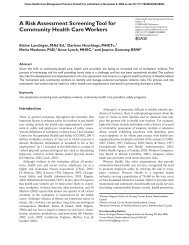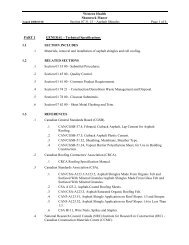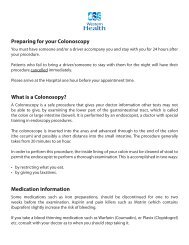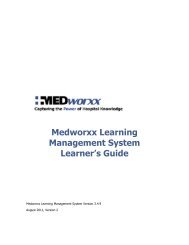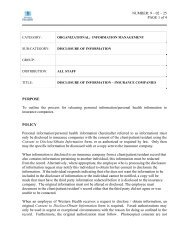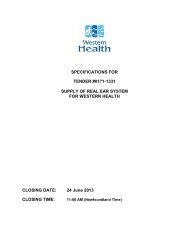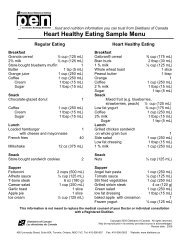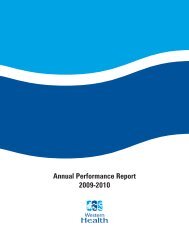Western Health's Strategic Plan 2008 - 2011 (PDF)
Western Health's Strategic Plan 2008 - 2011 (PDF)
Western Health's Strategic Plan 2008 - 2011 (PDF)
You also want an ePaper? Increase the reach of your titles
YUMPU automatically turns print PDFs into web optimized ePapers that Google loves.
<strong>Western</strong> Health December 4, 2007Message from the ChairpersonThe Board of Trustees of <strong>Western</strong> Health (see Appendix A) is pleased to present its <strong>Strategic</strong> <strong>Plan</strong>for <strong>2008</strong>-<strong>2011</strong>. The Values, Vision and Mission of <strong>Western</strong> Health will continue to provide thefoundational support to lead the organization into the future. The <strong>Strategic</strong> Goals respond to thechanging population demographics and the <strong>Strategic</strong> Directions of the Department of Health andCommunity Services (see Appendix B). This strategic plan will guide the development ofoperational plans throughout the organization, which collectively will enable <strong>Western</strong> Health toprogress towards its vision of the people of <strong>Western</strong> Newfoundland having the highest level ofhealth and well-being possible.The Board of Trustees of <strong>Western</strong> Health acknowledges the development of this plan in accordancewith legislative requirements defined in the Transparency and Accountability Act. <strong>Western</strong> Health isa category 1 government entity, as defined by the Transparency and Accountability Act. This is thefirst three-year strategic plan produced, in keeping with the Act. The Board of Trustees isaccountable for the preparation of this plan and for achieving the specific goals and objectives in thisplan. The Board is committed to reporting our progress each year in our annual report.On behalf of the Board of Trustees, I want to express appreciation to staff members, physicians,members of the Board <strong>Strategic</strong> <strong>Plan</strong>ning Committee, Chief Executive Officer, management,government representatives and our partners for their commitment and dedication to the strategicplanning process as evident in the successful completion of the first strategic plan, 2006-<strong>2008</strong>, for<strong>Western</strong> Health. The Board of Trustees also acknowledges significant investment from theProvincial Government, through the Department of Health and Community Services, to support theachievement of strategic and operational goals.Sincerely,Tony Genge, PhD<strong>Western</strong> Health <strong>Strategic</strong> <strong>Plan</strong> <strong>2008</strong>-<strong>2011</strong> 1
<strong>Western</strong> Health December 4, 2007Table of Contents1.0 Overview 3 - 42.0 Mandate 5 - 63.0 Lines of Business 7 - 104.0 Values 115.0 Primary Clients and Related Expectations 126.0 Vision 137.0 Mission Statement 13 - 148.0 <strong>Strategic</strong>/Governance Issues 15 - 209.0 Appendix A: Board of Trustees 2110.0 Appendix B: <strong>Strategic</strong> Directions 22 – 2411.0 Appendix C: Regional Map 25<strong>Western</strong> Health <strong>Strategic</strong> <strong>Plan</strong> <strong>2008</strong>-<strong>2011</strong> 2
<strong>Western</strong> Health December 4, 2007Atlantic join the regular students at <strong>Western</strong> Memorial Regional Hospital to complete the finaltwo years of the undergraduate program. Currently INAP is a one time offering.The organization employs 2931 staff (1894 permanent full-time (including 48 physicians), 199permanent part-time, 120 temporary full-time, 46 temporary part-time, 668 casual and four otherpermanent) who work in 53 sites throughout the region with its regional office located in CornerBrook.There are numerous volunteers who assist in delivering a number of programs and services andspecial events within acute care, long term care and community, which enhance the quality of lifefor patients, residents, and clients.In 2007-<strong>2008</strong>, <strong>Western</strong> Health has a budget of $249 million with most of its revenue coming fromprovincial plan funding through the Department of Health & Community Services. Other notablerevenues include long term care and the Medical Care <strong>Plan</strong> (MCP).Major expenditures include: salaries, direct client payments, capital costs, debt financing,diagnostic and therapeutic services, pharmaceuticals and medical supplies.An overview of <strong>Western</strong> <strong>Health's</strong> programs and services can be found at www.westernhealth.nl.ca.<strong>Western</strong> Health <strong>Strategic</strong> <strong>Plan</strong> <strong>2008</strong>-<strong>2011</strong> 4
<strong>Western</strong> Health December 4, 20072.0 MandateThe mandate of <strong>Western</strong> Health is derived from the Health and Community Services and theEstablishment of the Regional Health Authorities Act and its regulations. <strong>Western</strong> Health isresponsible for the delivery and administration of health and community services in the <strong>Western</strong>Health region in accordance with the above referenced legislation.In carrying out its responsibilities, <strong>Western</strong> Health shall:(a) promote and protect the health and well being of its region and develop and implementmeasures for the prevention of disease and injury and the advancement of health and wellbeing;(b) assess health and community services needs in its region on an ongoing basis;(c) develop objectives and priorities for the provision of health and community services whichmeet the needs of its region and which are consistent with provincial objectives andpriorities;(d) manage and allocate resources, including funds provided by the government for health andcommunity services, in accordance with Legislation;(e) ensure that services are provided in a manner that coordinates and integrates health andcommunity services;(f) collaborate with other persons and organizations, including federal, provincial, andmunicipal governments and agencies and other regional health authorities, to coordinatehealth and community services in the province and to achieve provincial objectives andpriorities;(g) collect and analyze health and community services information for use in the developmentand implementation of health and community services policies and programs for its region;(h) provide information to the residents of the region respecting- the services provided by the Authority- how they may gain access to those services and- how they may communicate with the authority respecting the provision ofthose services by the authority;(i) monitor and evaluate the delivery of health and community services and compliance<strong>Western</strong> Health <strong>Strategic</strong> <strong>Plan</strong> <strong>2008</strong>-<strong>2011</strong> 5
<strong>Western</strong> Health December 4, 2007with prescribed standards and provincial objectives and in accordance with guidelinesthat the minister may establish for the authority;(j) comply with directions the minister may give.In addition to the regional mandate, <strong>Western</strong> Health administers distinctive provincial servicessuch as the Provincial Cervical Screening Initiatives Program and the Provincial InpatientAddictions Treatment Program, Humberwood.The organization also has a role in the education of Nurses in collaboration with MemorialUniversity of Newfoundland and the Centre for Nursing Studies.<strong>Western</strong> Health <strong>Strategic</strong> <strong>Plan</strong> <strong>2008</strong>-<strong>2011</strong> 6
<strong>Western</strong> Health December 4, 20073.0 Lines of Business<strong>Western</strong> Health provides a continuum of programs and services to the people of westernNewfoundland that include primary health care, acute care, long term care and supportive services,education and provincial programming.A. Primary Health CarePrimary health care refers to the first level of contact people have with health and communityservices. This contact is usually with a family doctor, nurse practitioner, community health nurse,paramedic, social worker, child/behaviour management specialist, dietitian, etc.Primary Health Care is organized around the following services:• Emergency Services: An individual can access physician services by self or third party referralat any health care facility or community-based clinic across the region. Emergency services areavailable 24 hours a day at the two hospitals and the four main health centres. Ambulance servicesinclude both an emergency care and transportation component. Ambulance services are owned andoperated by <strong>Western</strong> Health at two sites: <strong>Western</strong> Memorial Regional Hospital and RufusGuinchard Health Centre. In addition, services owned and operated by private providers areutilized throughout the region. <strong>Western</strong> Health oversees the program and funding responsibility forthe road ambulance service, effective April 1, 2005. The ambulance services within the region areprovided by a Regional Emergency Medical Services system ensuring that emergency medicalservices personnel and equipment are delivered to the scene in a safe, cost effective and timelymanner. Clients are transported with appropriate level of care to appropriate facilities.• Nurse Practitioner: Nurse practitioner services can be accessed by self or third party referral atsites in Bonne Bay, Port Saunders, Port aux Basques, Ramea and Deer Lake.• Public Health: Essential public health functions include health promotion and health protection.Health promotion activities are integrated throughout all lines of business within <strong>Western</strong> Health.At a specific program level, health promotion offers a range of services including but not limitedto; nutrition, health education, diabetes education, breastfeeding support, healthy lifestyle,reproductive health, breast screening, environmental health, parent and child health, mental health,and addiction services. Health protection includes a range of programs and services in accordancewith current legislation. These programs and services include, but are not limited to,communicable disease surveillance, immunization, travel medicine, food safety, water quality,sanitation monitoring and intervention, disaster planning and injury prevention. There is a formalMemorandum of Understanding in place with Government Services. The Injury PreventionCoalition promotes proper use of car seats, bicycle helmet safety and other safety initiatives.<strong>Western</strong> Health <strong>Strategic</strong> <strong>Plan</strong> <strong>2008</strong>-<strong>2011</strong> 7
<strong>Western</strong> Health December 4, 2007• Community Health Nursing: Community health nursing services are offered to clients, families,and communities throughout the region. Clients may self refer and third party referrals are alsoaccepted. Programs include: immunization, prenatal, postnatal, child health, school health, anddisease control.• Mental Health and Addiction Services: These programs include but are not limited to:promotion, education, prevention, consultation, co-ordination, assessment, and counseling. Theseservices are offered to individuals, families, groups and communities for mental health /mentalillness-related issues and substance use/gambling issues. All services accept self-referrals orreferrals by third party. Specialized services include Blomidon Place, Humberwood TreatmentCentre, and West Lane Recycling Program, all located in Corner Brook, and Sexual AbuseCommunity Services (SACS) located in Stephenville.• Child, Youth, and Family Services: These programs and services include a wide range of earlyintervention, prevention and legislated programs to clients in the region. These programs andservices include, but are not limited to: residential placement, adoption services, protection ofchildren and youth, youth justice services, and licensed child care services. While some of theseservices are voluntary and accept self-referrals (adoption services, child care), others areinvoluntary, governed by legislation. Offices are located throughout the region in Port auxBasques, Burgeo, Stephenville, Stephenville Crossing, Piccadilly, Corner Brook, Deer Lake,Woody Point and Port Saunders.• Community Rehabilitation: These programs and services include: Audiology, Speech LanguagePathology, Developmental Psychology, Autism Services, Direct Home Services, Early ChildhoodDevelopment and Child Care. These services are available throughout the region at variouslocations. Speech Language Pathology, Direct Home Services, Audiology, and OccupationalTherapy services are available by self, professional or agency referrals. Autism Services andDevelopmental Psychology Services are available by professional or agency referrals.B. Acute Care<strong>Western</strong> Health offers a wide range of institutional, primarily medical and medical supportservices, at various locations throughout the region. Access to these services is through referral bygeneral practitioner or specialist. These services are offered on an inpatient, day surgery, andambulatory care basis. Hostel accommodations are available.Acute care services include:• Surgical services include anesthesiology, orthopedics, ophthalmology, dental, generalsurgery, otolaryngology, obstetrics and gynecology, urology, and vascular.• Maternal child health services include obstetrics and paediatrics.• Medical services include psychiatry, internal medicine, emergency room services, familymedicine, paediatrics, palliative care, neurology, physiatry, renal dialysis, intensive care,rheumatology, cardiology, gastroenterology and nephrology<strong>Western</strong> Health <strong>Strategic</strong> <strong>Plan</strong> <strong>2008</strong>-<strong>2011</strong> 8
<strong>Western</strong> Health December 4, 2007D. Education<strong>Western</strong> Health operates the <strong>Western</strong> Regional School of Nursing. A Bachelor of Nursingprogram is offered in co-operation with Memorial University of Newfoundland and the Centre forNursing Studies. Annual first year enrolment is limited to 59 students. Eight of these students areenrolled in a fast track program which is offered to individuals who wish to pursue a baccalaureatedegree in nursing at an accelerated pace. The Inuit Nursing Access program is offered inconjunction with the College of the North Atlantic. Enrolment is limited to 18 Inuit students.Clinical placements and internships and other selected training opportunities are offered to medicalstudents from Memorial University of Newfoundland. A variety of placements are available, atdesignated sites, to health professionals from various universities and colleges. Affiliationagreements exist with these facilities.E. Provincial Programs<strong>Western</strong> Health has the administrative responsibility for the Provincial Cervical ScreeningInitiatives Program. The provincial initiative will establish a comprehensive, organized approachto cervical screening through a staged implementation process. The scope of the programencompasses public/professional education, identification and recruitment of the target population,standardization of cytology and management of cytological diagnosis, continuous qualityimprovements, and coordination with other health authorities, organizations and stakeholders on aprovincial and national scale. As the infrastructure for the program develops, the goal of enhancedparticipation rates in cervical screening will facilitate the reduction of both incidence and mortalityof cervical cancer and improve health outcomes for women in Newfoundland and Labrador.As well, <strong>Western</strong> Health has responsibility for the provincial addictions inpatient facility,Humberwood, which is based in Corner Brook. This facility provides counseling services to adultsover 18 years who self refer or are referred by an agency or other professionals for chronicaddiction to alcohol, drugs and/or gambling. An assessment is required prior to admission to thefacility, which provides stays up to 19 days.<strong>Western</strong> Health <strong>Strategic</strong> <strong>Plan</strong> <strong>2008</strong>-<strong>2011</strong> 10
<strong>Western</strong> Health December 4, 20074.0 ValuesThe core values of <strong>Western</strong> Health offer principles and a guiding framework for all employees asthey work in their various capacities to protect the rights and freedoms of the people ofNewfoundland and Labrador. These core values and the related action statements are:RespectEquityTransparencyAdvocacyCollaborationExcellenceInnovationAccountabilityRespect:Equity:Transparency:Advocacy:Collaboration:Excellence:Innovation:Accountability:Each person provides opportunities for others to express themselves in anopen and safe environment.Each person provides individuals access to programs and services withinthe <strong>Western</strong> Region in a fair manner.Each person is forthcoming with all information related to decisionmaking,except where prohibited by legislation.Each person supports individuals in meeting their needs or overcomingbarriers.Each person works with others to enhance service delivery and maximizethe use of resources.Each person will do the best work possible within their skills and theresources available.Each person identifies opportunities to enhance programs and services.Each person follows through on his/her duties and responsibilities.<strong>Western</strong> Health <strong>Strategic</strong> <strong>Plan</strong> <strong>2008</strong>-<strong>2011</strong> 11
<strong>Western</strong> Health December 4, 20075.0 Primary Clients and Related Expectations<strong>Western</strong> Health is committed to effectively, and efficiently meeting the needs of its clients. Theprimary clients of <strong>Western</strong> Health are those individuals, families, and communities who avail of itsservices and programs. <strong>Western</strong> Health works with a broad range of partners such as staff, andphysicians that provide our programs and services, private service providers, general public,Department of Health and Community Services, community based agencies, private business,volunteer boards, non governmental agencies, other government departments both provincially andfederally, other health boards, Newfoundland and Labrador Health Boards Association, schoolboards, post secondary institutions, Memorial University of Newfoundland, College of the NorthAtlantic, municipal councils, professional associations, media, advisory committees, provincialand federal politicians, Members of the House of Assembly and Members of Parliament.<strong>Western</strong> Health <strong>Strategic</strong> <strong>Plan</strong> <strong>2008</strong>-<strong>2011</strong> 12
<strong>Western</strong> Health December 4, 20076.0 VisionThe vision of <strong>Western</strong> Health is that the people of <strong>Western</strong> Newfoundland have the highestlevel of health and well being possible.7.0 Mission Statement<strong>Western</strong> Health is a new organization that came into existence through the integration of theformer Health and Community Services <strong>Western</strong> and <strong>Western</strong> Health Care Corporation onApril 1, 2005. As a new organization, integration of programs and services will supportresidents in achieving the highest level of health and well being possible. The followingmission statement was determined to provide direction over the next six years in the pursuit ofour vision. As the measures and indicators suggest, the mission statement supports all four ofGovernment's strategic directions.By March 31, <strong>2011</strong>, <strong>Western</strong> Health will have integrated and coordinated programs andservices, starting with priority areas, to address the population health needs of the <strong>Western</strong>Region within financial resources.Measure 1:Programs and services are integrated and coordinated to address the populationhealth needs of the <strong>Western</strong> region.Indicators:1. Mechanism established for ongoing evaluation of community needs in the <strong>Western</strong>Region.2. Improved access to programs and services starting with five key priority areasidentified by federal and provincial ministers.3. The development of a Regional Health Services <strong>Plan</strong>, in keeping with the foundationalcomponents developed by Department of Health and Community Services.4. Implementation of components of a Regional Health Services <strong>Plan</strong>:a. Integration of services based on current needs and fiscal resources withinpriority areas within community based services to Children and Youthi. A framework is in place for community-based services to children andyouthii. Initiated program and service changes to reflect coordinationb. Integration of priority areas of community based and acute care mental healthand addiction servicesi. A framework is in place for mental health and addiction servicesii. Initiated program and service changes to reflect coordinationc. Implementation of priority areas within regional primary health care plan in<strong>Western</strong> Health <strong>Strategic</strong> <strong>Plan</strong> <strong>2008</strong>-<strong>2011</strong> 13
<strong>Western</strong> Health December 4, 2007keeping with the Provincial Framework for Primary Health Cared. Improved access to programs and services starting with five key priority areasidentified by federal and provincial ministers.e. Devolution of programs and services identified by the Department of Healthand Community Services to <strong>Western</strong> Healthf. Development of a Health Promotion Frameworkg. Implemented programs and services supporting the provincial Healthy AgingFramework in priority areash. Implemented chronic disease management and prevention model in priorityareasMeasure 2:Programs and services are provided within financial resourcesIndicators:• Financial <strong>Plan</strong>, is developed in consultation with the Department of Health andCommunity Services, to achieve an operating budget up to the level of expectedrevenues, and outlines implications for service delivery• Financial <strong>Plan</strong> is implemented• Programs and service indicators are developed and reported on a regular basis to theBoard including provincial or national benchmarks where available and targets• A plan is developed to address the organization’s operating deficit that outlinesimplications for service delivery.<strong>Western</strong> Health <strong>Strategic</strong> <strong>Plan</strong> <strong>2008</strong>-<strong>2011</strong> 14
<strong>Western</strong> Health December 4, 20078.0 <strong>Strategic</strong>/Governance Issues<strong>Strategic</strong> Issue One: Healthy Aging<strong>Western</strong> Health recognizes that the population of the <strong>Western</strong> Region has declined by nearly 11%from 1996 to 2001 (the second largest decline in the province), while the segment of the region’stotal population over age 65 actually increased 9% during the same period. The proportion ofpopulation aged 65 and older is marginally greater in the <strong>Western</strong> Region (13.1%) when comparedto the provincial proportion (12.3%). It is predicted that within 10 years, 20% of Newfoundland’sresidents will be over the age of 65. In 2007, 13.9% of the population in Newfoundland andLabrador were aged 65 and older (data compiled by the Community Accounts Unit based uponinformation from the Census of Population 1986, 1991, 1996 and 2001, Statistics Canada). In2004, 37% of all admissions to <strong>Western</strong> Health facilities were aged 65 and older. In June 2007,the province released its Healthy Aging Policy Framework. The document outlines the key issuesand strategic directions that will prepare the province to respond to the needs of seniors now and inthe future. In keeping with Government's strategic direction to improve population health,supporting healthy aging and a culture of respect for older adults through the development of aplan for the implementation of the provincial framework is a strategic issue for <strong>Western</strong> Health.Goal One:Measure:By March 31, <strong>2011</strong>, <strong>Western</strong> Health will have implemented programs andservices which support the Provincial Healthy Aging Framework to meet theneeds of the aging population of the <strong>Western</strong> region.Implemented programs and servicesIndicators:• Implemented programs and services in priority areas of the FrameworkObjectives:1. By March 31, 2009, <strong>Western</strong> Health will have identified the health service needs of theaging population within the <strong>Western</strong> region.Measure:Needs of the aging population identifiedIndicators:• Environmental scan completed<strong>Western</strong> Health <strong>Strategic</strong> <strong>Plan</strong> <strong>2008</strong>-<strong>2011</strong> 15
<strong>Western</strong> Health December 4, 20072. By March 31, 2010, <strong>Western</strong> Health will develop a plan which supports the ProvincialHealthy Aging Framework to meet the health services needs of the aging population in the<strong>Western</strong> region.3. By March 31, <strong>2011</strong>, <strong>Western</strong> Health will have implemented a plan whichsupports the Provincial Healthy Aging Framework in priority areas.<strong>Western</strong> Health <strong>Strategic</strong> <strong>Plan</strong> <strong>2008</strong>-<strong>2011</strong> 16
<strong>Western</strong> Health December 4, 2007<strong>Strategic</strong> Issue Two: Chronic Disease Prevention and ManagementThe incidence of chronic diseases especially diabetes, heart disease and some cancers contribute topoorer health outcomes for residents of Newfoundland and Labrador. In the <strong>Western</strong> Region, thepercentage of the population aged twelve years and older, with diabetes, rose from 5.8% in 2003 to7.6% in 2005. (Canadian Community Health Survey, 2003 and 2005). The 2005 western regionalmortality rate (per 100,000 population) for stroke was 48.4 as compared to 37.0 nationally. In2003, the leading causes of death for the province and Regional Integrated Health Authorities werediseases of the circulatory system and cancer (Mortality Statistics Newfoundland and LabradorRegional Integrated Health Authorities, 2000-2004). The incidences of the chronic diseases suchas diabetes, heart disease, and cancer, may be attributable to unhealthy behaviors and healthpractices. The Canadian Community Health Survey in 2005 reported that 24.9% of the populationaged twelve years and older reported that they were occasional smokers, 41.9% of the populationaged eighteen years and older reported that they were overweight, 23.6% of the population agedtwenty to sixty-four years reported that they were obese and 49.6% of the population aged twelveyears and older reported that they were physically active. To support Government's strategicdirection of improving population health, strengthening chronic disease prevention andmanagement through the implementation of an integrated chronic disease prevention andmanagement model is a strategic issue for <strong>Western</strong> Health.Goal Two:Measure:By March 31, <strong>2011</strong>, <strong>Western</strong> Health will have enhanced service delivery tosupport chronic disease prevention and management.Enhanced service deliveryIndicators:• Implemented a chronic disease prevention and management model in priorityareasObjectives:1. By March 31, 2009, <strong>Western</strong> Health will have approved a chronic disease prevention andmanagement model.Measure:Board approved modelIndicators:• Chronic disease prevention and management model with priority action areasidentified2. By March 31, 2010, <strong>Western</strong> Health will have developed an implementation plan for a<strong>Western</strong> Health <strong>Strategic</strong> <strong>Plan</strong> <strong>2008</strong>-<strong>2011</strong> 17
<strong>Western</strong> Health December 4, 2007chronic disease management and prevention model in priority areas.3. By March 31, <strong>2011</strong>, <strong>Western</strong> Health will have implemented a chronic disease managementand prevention model in priority areas.<strong>Western</strong> Health <strong>Strategic</strong> <strong>Plan</strong> <strong>2008</strong>-<strong>2011</strong> 18
<strong>Western</strong> Health December 4, 2007<strong>Strategic</strong> Issue Three: Patient SafetyIn Canada, the emphasis on patient safety increased with the Canadian Adverse Events Study: TheIncidence of Adverse Events Among Hospital Patients in Canada (Baker et al 2004). Followingthe study, the National Steering Committee on Patient Safety presented a national strategy onpatient safety. In support of the strategy, <strong>Western</strong> Health defines patient safety as: the reductionand mitigation of unsafe acts within the health care system, as well as through the use of bestpractices shown to lead to optimal patient outcomes (The Canadian Patient Safety Dictionary,October 2006). <strong>Western</strong> Health recognizes this definition and is committed to the following: (a)creating a culture that supports the identification and reporting of unsafe acts; (b) effectivemeasurement of client/patient/resident injuries and other relevant outcome indicators; (c) tools fordeveloping or adapting structures and processes to reduce reliance on individual vigilance. Inkeeping with Government's strategic direction of improving accountability and stability in thedelivery of the health and community services, the development, implementation and evaluation ofpriority initiatives, in a patient safety work plan, to enable a culture of safety is a strategic issue for<strong>Western</strong> Health.Goal Three: By March 31, <strong>2011</strong>, <strong>Western</strong> Health will have implemented priority initiativesin a patient safety work plan for improved performance outcomes.Measure:Implementation of priority initiatives in a patient safety work planIndicators:• Established processes for stakeholder involvement• Completed environmental scan• Implemented initiatives to address the priority components of a patient safetywork plan• Regional processes for reporting, analyzing and evaluating patient safetyperformance outcomes• Improved performance outcomes related to the initiativesObjectives:1. By March 31, 2009, <strong>Western</strong> Health will have identified the components of a patientsafety work plan.Measure:Components of the work plan identifiedIndicators:• Completed literature review• Completed regional environmental scan<strong>Western</strong> Health <strong>Strategic</strong> <strong>Plan</strong> <strong>2008</strong>-<strong>2011</strong> 19
<strong>Western</strong> Health December 4, 2007• Identified components of a patient safety work plan2. By March 31, 2010, <strong>Western</strong> Health will have developed and implemented aconsultative process for identifying and prioritizing the components of a patient safetywork plan.3. By March 31, <strong>2011</strong>, <strong>Western</strong> Health will have implemented priority initiatives of a patientsafety work plan.<strong>Western</strong> Health <strong>Strategic</strong> <strong>Plan</strong> <strong>2008</strong>-<strong>2011</strong> 20
<strong>Western</strong> Health December 4, 20079.0 Appendix ABoard of TrusteesDr. Anthony Genge, ChairMs. Tina Moores, Vice ChairMr. Don FudgeMs. Diane HewittMs. Madonna Hynes (resigned March 8, <strong>2008</strong>)Mr. David KennedyMr. John Manual (deceased March 4, <strong>2008</strong>)Ms. Sheila MercerMr. Tom O'BrienMs. Evelyn OrganMr. Charles PenderMr. Wayne PyeMs. Minnie Vallis (resigned November 7, 2007)Ms. Regina Warren<strong>Western</strong> Health <strong>Strategic</strong> <strong>Plan</strong> <strong>2008</strong>-<strong>2011</strong> 21
<strong>Western</strong> Health December 4, 200710.0 Appendix B<strong>Strategic</strong> DirectionsThis Direction is/wasGovernment’s<strong>Strategic</strong> Direction(as communicated bythe responsibledepartment)Focus Areas of the<strong>Strategic</strong> DirectionNot beingimplementedat this time(rationaleincluded in theplan)Addressedonly inspecific subareas(rationaleincluded inthe plan)strategicplanAddressed in the:operationalplanbranch/divisionalwork-plansImprovepopulation healthObesityUSmoking rates andprotection fromenvironmental smokeUDental health ofchildrenUSupport for healthyagingUAboriginal healthneedsYStrengthen publichealth capacitySurveillance forcommunicablediseaseHealth emergencyplan for the HCSsystemEnvironmental healthpolicyYUUImproveaccessibility topriority servicesAccess tocommunity-basedmental health andaddictions servicesAccess to appropriateprimary healthservicesUU<strong>Western</strong> Health <strong>Strategic</strong> <strong>Plan</strong> <strong>2008</strong>-<strong>2011</strong> 22
<strong>Western</strong> Health December 4, 2007This Direction is/wasGovernment’s<strong>Strategic</strong> Direction(as communicated bythe responsibledepartment)Focus Areas of the<strong>Strategic</strong> DirectionNot beingimplementedat this time(rationaleincluded in theplan)Addressedonly inspecific subareas(rationaleincluded inthe plan)strategicplanAddressed in the:operationalplanbranch/divisionalwork-plansHome care andsupport servicesavailable in the areasof end of life care,acute short termcommunity mentalhealth, casemanagement, shortterm post dischargeIV medications andwound managementUOptions to supportchoices of individualsin need of long termcare and communitysupportsUAccess to astrengthened child,youth and familyserviceUAccess to qualityearly learning andchild careUImproveaccountabilityand stability inthe delivery of thehealth andcommunityservices withinavailableresourcesIdentify and monitoroutcomes for selectedprogramsAchievement ofbalanced budgetsStabilize humanresourcesQuality managementand patient safetyUUUU<strong>Western</strong> Health <strong>Strategic</strong> <strong>Plan</strong> <strong>2008</strong>-<strong>2011</strong> 23
<strong>Western</strong> Health December 4, 2007<strong>Strategic</strong> Direction Area of Focus: Aboriginal Health Needs<strong>Western</strong> Health is working with the Department of Health and Community Services in thedevelopment of the Aboriginal Health Project and, in keeping with this project, staff is meetingwith aboriginal groups to support them in developing proposals to access health transitionfunding. <strong>Western</strong> Health will build on these beginning efforts and directions to support branchplanning, related to this area of focus, for year two and three of the <strong>2008</strong>-11 planning cycle.<strong>Western</strong> Health <strong>Strategic</strong> <strong>Plan</strong> <strong>2008</strong>-<strong>2011</strong> 24
<strong>Western</strong> Health December 4, 200711.0 Appendix CRegional Map<strong>Western</strong> Health <strong>Strategic</strong> <strong>Plan</strong> <strong>2008</strong>-<strong>2011</strong> 25



